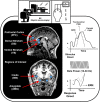Forging Neuroimaging Targets for Recovery in Opioid Use Disorder
- PMID: 30899231
- PMCID: PMC6417368
- DOI: 10.3389/fpsyt.2019.00117
Forging Neuroimaging Targets for Recovery in Opioid Use Disorder
Abstract
The United States is in the midst of an opioid epidemic and lacks a range of successful interventions to reduce this public health burden. Many individuals with opioid use disorder (OUD) consume drugs to relieve physical and/or emotional pain, a pattern that may increasingly result in death. The field of addiction research lacks a comprehensive understanding of physiological and neural mechanisms instantiating this cycle of Negative Reinforcement in OUD, resulting in limited interventions that successfully promote abstinence and recovery. Given the urgency of the opioid crisis, the present review highlights faulty brain circuitry and processes associated with OUD within the context of the Three-Stage Model of Addiction (1). This model underscores Negative Reinforcement processes as crucial to the maintenance and exacerbation of chronic substance use together with Binge/Intoxication and Preoccupation/Anticipation processes. This review focuses on cross-sectional as well as longitudinal studies of relapse and treatment outcome that employ magnetic resonance imaging (MRI), functional near-infrared spectroscopy (fNIRs), brain stimulation methods, and/or electroencephalography (EEG) explored in frequency and time domains (the latter measured by event-related potentials, or ERPs). We discuss strengths and limitations of this neuroimaging work with respect to study design and individual differences that may influence interpretation of findings (e.g., opioid use chronicity/recency, comorbid symptoms, and biological sex). Lastly, we translate gaps in the OUD literature, particularly with respect to Negative Reinforcement processes, into future research directions involving operant and classical conditioning involving aversion/stress. Overall, opioid-related stimuli may lessen their hold on frontocingulate mechanisms implicated in Preoccupation/Anticipation as a function of prolonged abstinence and that degree of frontocingulate impairment may predict treatment outcome. In addition, longitudinal studies suggest that brain stimulation/drug treatments and prolonged abstinence can change brain responses during Negative Reinforcement and Preoccupation/Anticipation to reduce salience of drug cues, which may attenuate further craving and relapse. Incorporating this neuroscience-derived knowledge with the Three-Stage Model of Addiction may offer a useful plan for delineating specific neurobiological targets for OUD treatment.
Keywords: abstinence; electroencephalography; event related potentials; magnetic resonance imaging; neuroimaging; opioid use disorder; recovery.
Figures




Similar articles
-
Bouncing back: Brain rehabilitation amid opioid and stimulant epidemics.Neuroimage Clin. 2019;24:102068. doi: 10.1016/j.nicl.2019.102068. Epub 2019 Nov 5. Neuroimage Clin. 2019. PMID: 31795056 Free PMC article. Review.
-
Resting-State Neuroimaging and Neuropsychological Findings in Opioid Use Disorder during Abstinence: A Review.Front Hum Neurosci. 2017 Apr 6;11:169. doi: 10.3389/fnhum.2017.00169. eCollection 2017. Front Hum Neurosci. 2017. PMID: 28428748 Free PMC article. Review.
-
Can neuroimaging help combat the opioid epidemic? A systematic review of clinical and pharmacological challenge fMRI studies with recommendations for future research.Neuropsychopharmacology. 2019 Jan;44(2):259-273. doi: 10.1038/s41386-018-0232-4. Epub 2018 Oct 3. Neuropsychopharmacology. 2019. PMID: 30283002 Free PMC article.
-
Effects of extended-release naltrexone on the brain response to drug-related stimuli in patients with opioid use disorder.J Psychiatry Neurosci. 2018 Jul;43(4):254-261. doi: 10.1503/jpn.170036. J Psychiatry Neurosci. 2018. PMID: 29947607 Free PMC article. Clinical Trial.
-
Protracted abstinence in males with an opioid use disorder: partial recovery of nucleus accumbens function.Transl Psychiatry. 2022 Feb 26;12(1):81. doi: 10.1038/s41398-022-01813-4. Transl Psychiatry. 2022. PMID: 35217657 Free PMC article.
Cited by
-
Non-Opioid Treatments for Opioid Use Disorder: Rationales and Data to Date.Drugs. 2020 Oct;80(15):1509-1524. doi: 10.1007/s40265-020-01373-1. Drugs. 2020. PMID: 32776315 Free PMC article. Review.
-
Neuroscience and addiction research: current advances and perspectives.J Neural Transm (Vienna). 2024 May;131(5):405-408. doi: 10.1007/s00702-024-02763-5. Epub 2024 Mar 16. J Neural Transm (Vienna). 2024. PMID: 38492013 No abstract available.
-
Cognitive profiles in persons with opioid use disorder enrolled in methadone treatment.Appl Neuropsychol Adult. 2022 Jul-Aug;29(4):462-468. doi: 10.1080/23279095.2020.1769099. Epub 2020 May 28. Appl Neuropsychol Adult. 2022. PMID: 32463730 Free PMC article.
-
Gene coexpression patterns predict opiate-induced brain-state transitions.Proc Natl Acad Sci U S A. 2020 Aug 11;117(32):19556-19565. doi: 10.1073/pnas.2003601117. Epub 2020 Jul 21. Proc Natl Acad Sci U S A. 2020. PMID: 32694207 Free PMC article.
-
Integrating cognitive bias modification for pain and opioid cues into medication for opioid use disorder clinical care: Feasibility, acceptability, and preliminary results.Drug Alcohol Depend. 2023 May 1;246:109857. doi: 10.1016/j.drugalcdep.2023.109857. Epub 2023 Mar 28. Drug Alcohol Depend. 2023. PMID: 37004461 Free PMC article. Clinical Trial.
References
-
- Hagemeier NE. Introduction to the opioid epidemic: the economic burden on the healthcare system and impact on quality of life. Am J Manag Care. (2018) 24, S200–6. - PubMed
Publication types
Grants and funding
LinkOut - more resources
Full Text Sources

